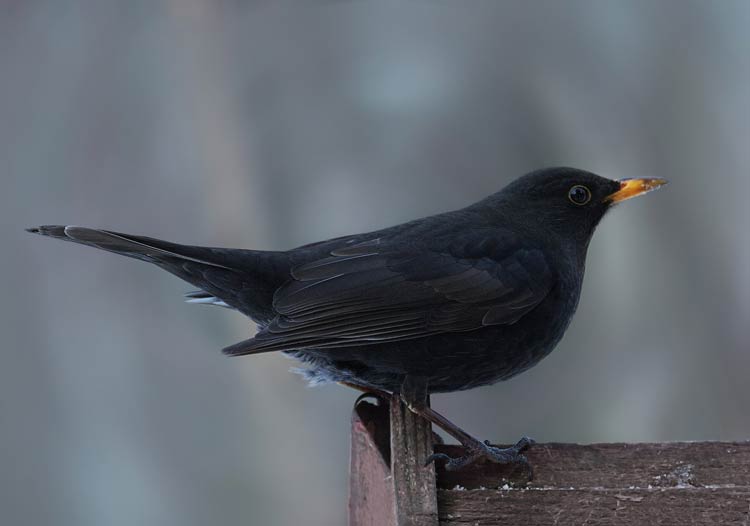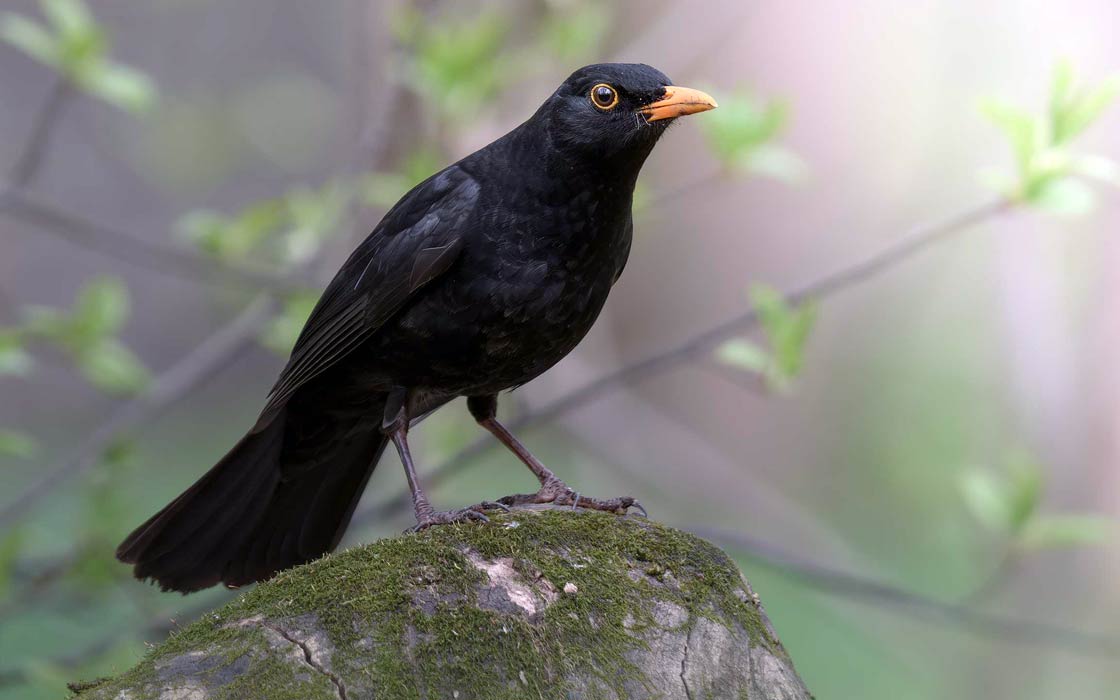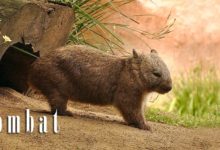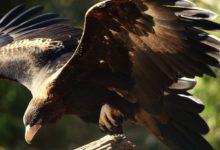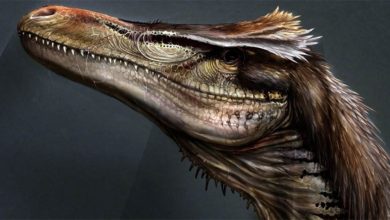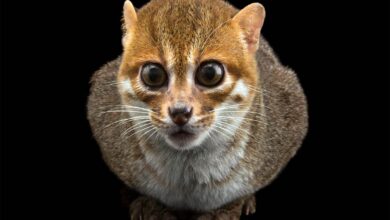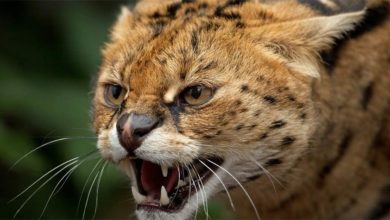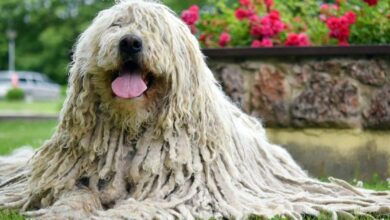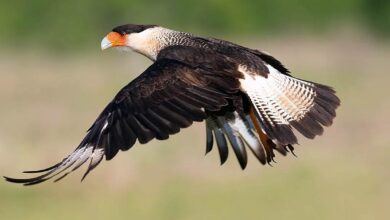The common blackbird (Turdus merula)
The Blackbird (Turdus merula) is one of Europe’s most recognizable birds. Its melodic, flute-like song, resounding at dawn and dusk, is a symbol of spring and an inseparable element of the soundscape of forests, parks, and gardens. This medium-sized bird, with distinctive black plumage in males and more modest, brown plumage in females, has gained people’s affection due to its proximity and remarkable ability to adapt to living alongside humans. The Blackbird is not only a talented singer but also an example of evolutionary success in diverse environments.
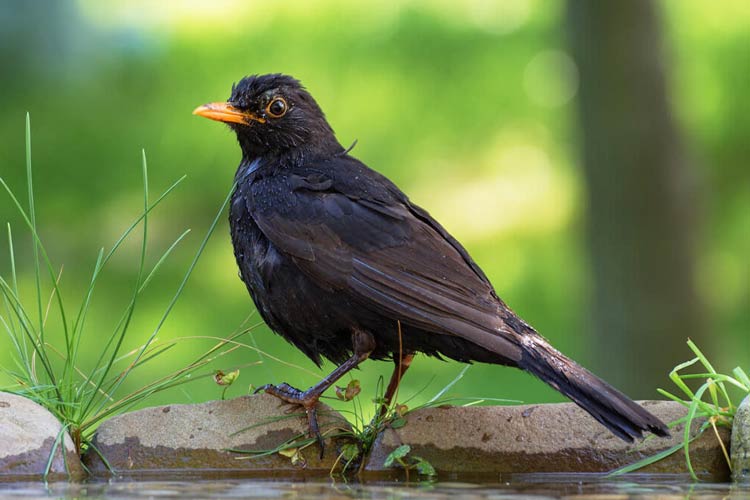
Classification
The Blackbird (Turdus merula) is a species of bird from the thrush family (Turdidae), belonging to the order Passeriformes. It was described by Carl Linnaeus in 1758 in the tenth edition of Systema Naturae under the name Turdus merula (Latin: turdus = thrush, merula = blackbird). Its taxonomic position is as follows:
- Kingdom: Animals (Animalia)
- Phylum: Chordates (Chordata)
- Subphylum: Vertebrates (Vertebrata)
- Class: Birds (Aves)
- Subclass: Neornithes
- Infraclass: Neognathae
- Order: Passeriformes
- Suborder: Passeri
- Family: Thrushes (Turdidae)
- Subfamily: Turdinae
- Genus: Turdus
- Species: Blackbird, common blackbird, Eurasian blackbird (Turdus merula)
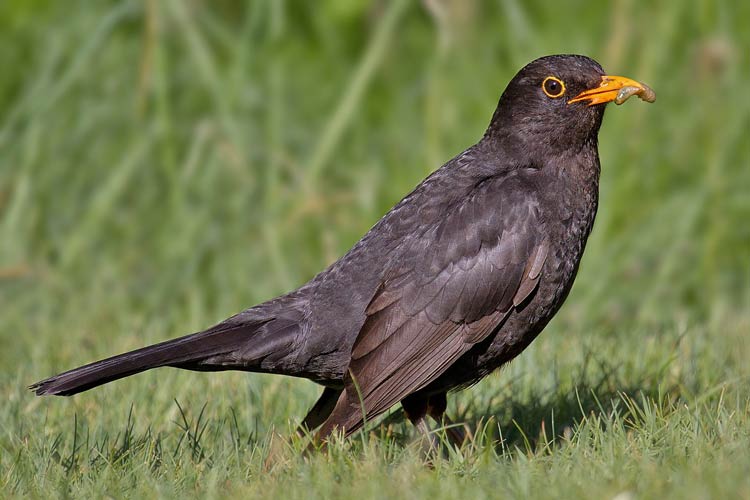
Subspecies
The International Ornithological Committee (IOC) recognizes seven subspecies of the Blackbird (Turdus merula), differing in plumage details, size, and range.
- Turdus merula merula (Linnaeus, 1758)
- Description: The nominate** subspecies encompassing most European populations (with the exception of southeastern Europe). Males have black, glossy plumage, a yellow bill, and a distinct yellow eye-ring. Females are dark brown with a mottled belly. Populations introduced in Australia and New Zealand originate mainly from this subspecies and do not differ significantly from European ones.
- Range: Almost all of Europe (except the Azores, Canary Islands, and Madeira), naturalized populations in Australia and New Zealand.
- The subspecies ticehursti was proposed for darker-plumaged blackbirds from Scotland and Ireland, but this was not accepted.
- Turdus merula azorensis (Hartert, 1905)
- Description: An endemic* subspecies to the Azores, smaller than the nominate subspecies, with a shorter tail. Males have darker, more glossy plumage.
- Range: Azores.
- Notes: Adaptation to the island environment has resulted in smaller body size.
- Turdus merula cabrerae (Hartert, 1901)
- Description: Similar to T. m. azorensis, but differs less from the nominate subspecies in terms of plumage and tail size.
- Range: Madeira and the western Canary Islands.
- Turdus merula mauritanicus (Hartert, 1902)
- Description: Males have deep black, glossy plumage and a slightly stronger bill.
- Range: Northwest Africa (from Morocco to Tunisia). In southern Spain, populations show intermediate characteristics with T. m. merula.
- Notes: Well adapted to dry conditions.
- Turdus merula aterrimus (Madarász, 1903)
- Description: Males have duller, less glossy plumage, and females have paler underparts. The bill is longer and narrower than in T. m. merula.
- Range: The Balkans, Slovenia, southern Romania, Crimea, Greece, Turkey, the Caucasus, northern Iran.
- Notes: Occurs at the boundary of the European and Asian ranges.
- Turdus merula syriacus (Hemprich & Ehrenberg, 1833)
- Description: Similar to T. m. aterrimus, but smaller. The subspecies T. m. insularum was proposed for populations on the southern Greek islands, but they are usually assigned to T. m. syriacus.
- Range: Eastern Mediterranean coasts (southern Turkey, Jordan, Israel, northern Sinai), northern Iraq, southern Iran.
- Notes: Adaptation to a warmer climate.
- Turdus merula intermedius (Richmond, 1896)
- Description: Larger than T. m. syriacus and T. m. aterrimus, with a longer tail and a stronger bill.
- Range: Breeds from northeastern Afghanistan to the Tian Shan mountains; winters in the valleys of southern Afghanistan and southern Iraq.
- Notes: Occurs in the mountainous regions of Central Asia.
*An endemic species is a species of plant or animal that occurs naturally only in a strictly defined, limited geographical area and is not found anywhere else in the world.
**A nominate subspecies, also known as the typical subspecies, is the “main” group within a species that shares the same name as the entire species. It is the subspecies from which scientists first began to describe the species.
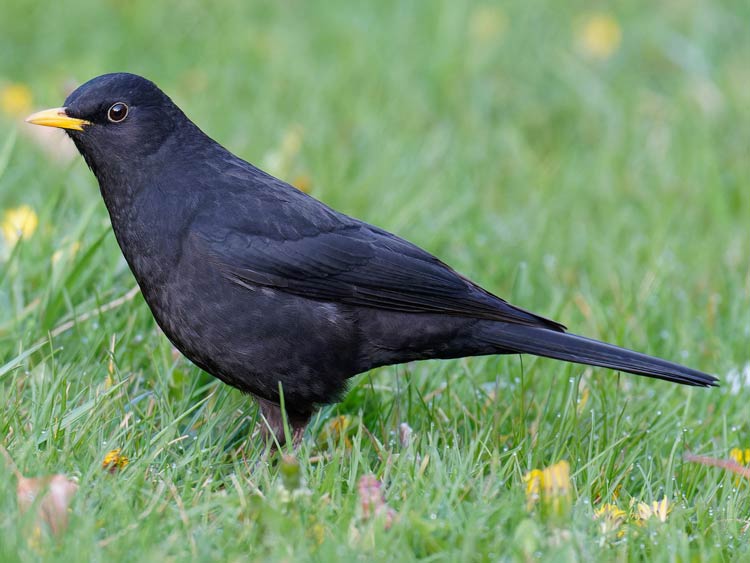
Distribution and Habitats
The Blackbird inhabits almost all of Europe (with the exception of the far north and southeastern extremes), parts of North Africa (from Morocco to Tunisia), and western and Central Asia, reaching the mountains of Central Asia in the east. It has been introduced* in Australia, New Zealand, and some islands in the South Pacific. In Poland, it is one of the most common birds, present in both rural areas and cities.
Originally, the Blackbird was a forest bird, preferring moist deciduous and mixed forests with dense undergrowth. in the 19th century, it began the process of synurbanization**, colonizing parks, gardens, and subsequently city centers. Currently, it occurs in diverse habitats: forests, woodlands, parks, squares, allotment gardens, and even industrial areas, provided that thickets and open spaces for foraging are available. In the mountains, e.g., in the Alps, Tatras, or Karkonosze, it nests up to the upper forest limit (in Poland up to 1,400 m above sea level (4,600 ft)).
*An introduction is the bringing of a plant, animal, or other organism to a new location (e.g., another country or continent) where it did not previously occur. Usually, humans bring such a species intentionally or accidentally.
** Synurbanization is a process in which wild animals adapt to living in cities and benefit from the conditions found there. This means that animals learn to live close to humans, tolerate their presence, and are able to utilize resources that humans create, such as food, shelter, or the warmth of buildings.
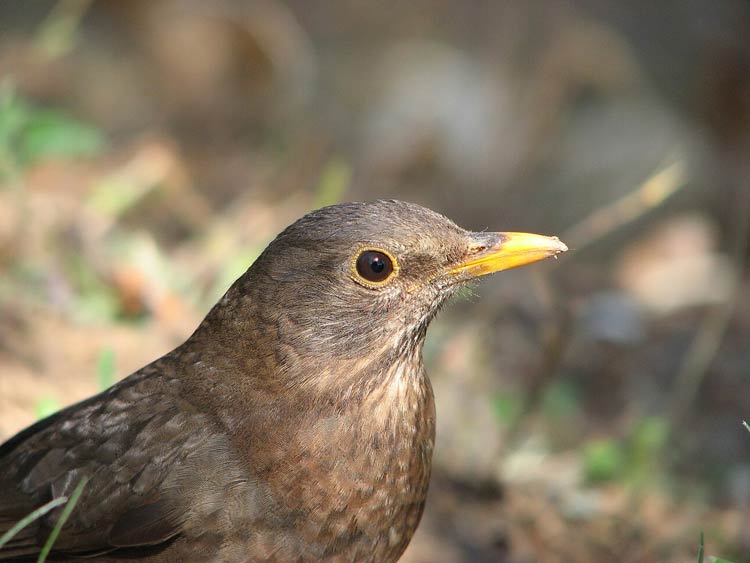
Characteristics
Appearance
The Blackbird exhibits distinct sexual dimorphism. Males have uniformly black, glossy plumage, a yellow bill, and a yellow eye-ring, contrasting with a dark brown iris. Females and juveniles are dark brown, with a lighter, mottled belly, which provides camouflage. Atypical colorations, such as leucism* or albinism, occur rarely, especially in urban populations.
Body length is 23.5–29 cm (9.3–11.4 in), wingspan is 34–39 cm (13.4–15.4 in), tail length is 10.4–11.6 cm (4.1–4.6 in). Body mass ranges from 71 to 150 g (2.50–5.29 oz), with the highest value in winter (fat storage) and the lowest in summer.
*Leucism is a genetic anomaly resulting in a partial or complete lack of pigment (melanin) in the skin, fur, feathers, or scales of animals, causing them to have pale, often white coloration. Unlike albinism, in leucism, animals have normal eye color and the color of other body parts not covered by pigment.

Behavior, Lifestyle, and Ecology
The Blackbird leads a partially migratory lifestyle. In Central Europe, including Poland, part of the population winters in place, while another part migrates south (e.g., to southern Europe or North Africa). Migrations occur mainly at night, in small stages. In cities, blackbirds are more sedentary, which may be genetically determined.
It is a territorial bird, especially during the breeding season. Males mark their territory with loud singing, performed from exposed locations (trees, roofs, antennas). The song is melodic, composed of catchy phrases, often imitating the calls of other birds or ambient sounds (e.g., sirens). Blackbirds are active from dawn till dusk, foraging on the ground with characteristic hops. At night, they roost alone or in groups, usually in dense thickets or on coniferous trees.
In the ecosystem, blackbirds play an important role by controlling invertebrate populations and dispersing the seeds of fruit-bearing plants. Their excellent vision after dusk facilitates foraging in low light.
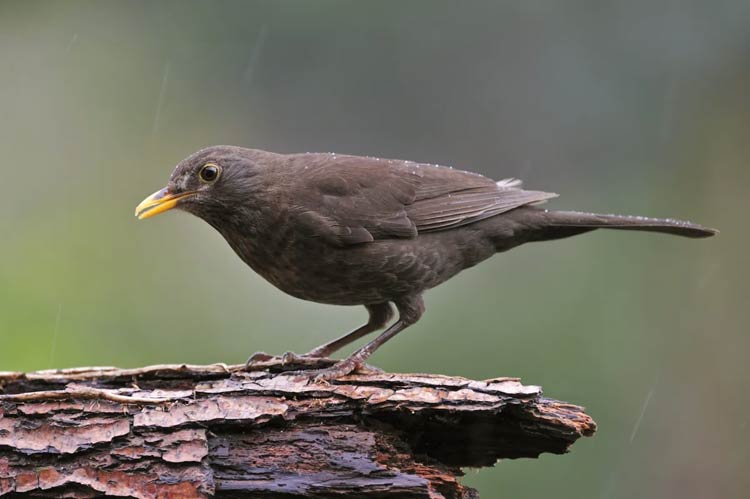
Diet
The Blackbird is omnivorous, and its diet changes seasonally:
- Spring and Summer Mainly invertebrates, such as earthworms, beetles, snails, spiders, as well as small vertebrates (e.g., lizards, amphibians). It also eats larval stages of insects.
- Autumn and Winter Fruits and berries dominate (e.g., rowan, hawthorn, common ivy, blackberries). In cities, it utilizes bird feeders, food scraps, and refuse.
Blackbirds forage on the ground, raking through leaf litter or quickly picking up leaves with their beaks. They collect fruits from the ground, bushes, or knock them down in flight. They form pellets from undigested remains. In extreme cases, coprophagy and cannibalism have been recorded.
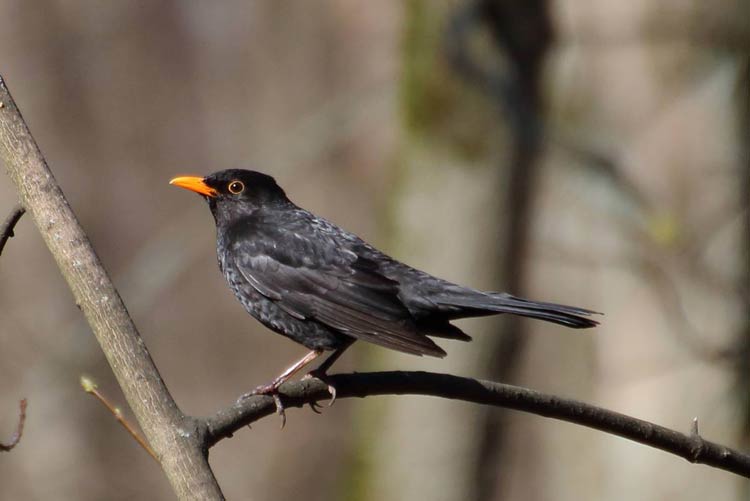
Reproduction and Parenting
The breeding season lasts from late February to late August, with 2–3 broods per year. The female builds a cup-shaped nest from twigs, moss, grasses, and mud, usually at a height of 1.5–2 m (4.9–6.6 ft) in bushes, trees, or climbers. In cities, nests are sometimes placed in unusual locations, such as in flowerpots, on joists, or even in engine compartments(!).
The female lays 3–5 bluish-green eggs with reddish-brown spots (29.5 × 21.5 mm (1.16 × 0.85 in), mass ~7 g (~0.25 oz)). Incubation lasts 10–19 days (average 13), mainly by the female. Hatchlings, naked and blind after hatching, are fed by both parents, mainly with animal food. They leave the nest after 13–15 days, reaching a mass of ~65 g (~2.29 oz), but remain dependent on their parents for another 2–3 weeks. Breeding success is higher outside cities, where there is less threat from cats and humans.
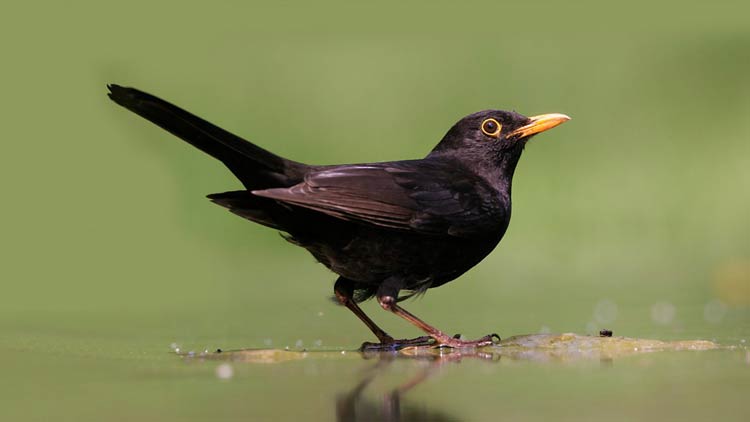
Predators and Threats
Blackbirds fall prey to birds of prey (e.g., Northern Goshawk (Accipiter gentilis), Eurasian Sparrowhawk (Accipiter nisus)), owls (e.g., Tawny Owl (Strix aluco)), corvids (magpies, crows), domestic cats, foxes, martens, and rats. Eggs and chicks are particularly vulnerable to magpies and squirrels. In cities, threats include collisions with vehicles and windows.
Parasites, such as nematodes (Isospora, Capillaria), protozoa (Haemoproteus, Leucocytozoon), and ticks (Ixodes), are common, especially in rural areas. The Usutu virus, transmitted by mosquitoes, caused mass die-offs of blackbirds in Central Europe (e.g., in Austria and Germany in 2001–2011). Climate change, pesticides, and habitat loss can limit food availability, especially in winter and during droughts.

Interactions with Humans
The Blackbird has adapted well to urban life, utilizing lawns, bird feeders, and refuse. Its song is valued by nature enthusiasts, and its presence in gardens is considered a sign of a healthy ecosystem. In culture, the blackbird symbolizes spring, renewal, and piety (e.g., the legend of St. Kevin). In folklore, it was believed to protect against lightning or predict the weather.
The blackbird can be problematic in orchards and vineyards, where it eats fruit, and in cities, where it fouls pavements with droppings. In Australia, it is considered a pest and is culled. Historically, blackbirds were kept in cages for their song or fattened for meat (e.g., in ancient Rome).
Population
The Blackbird population is stable and numerous. In Europe, the breeding population is estimated at 40–82 million pairs (120–246 million individuals), which constitutes 50–74% of the global population (162–492 million). In Poland, in the years 2013–2018, the population numbered 2.786–3.865 million breeding pairs, with a 59% increase since 2007, partly due to synanthropization* and climate warming. The highest density occurs in cities (up to 4–7 pairs/ha (1.6–2.8 pairs/acre)), while in forests it is lower (~0.5 pairs/ha (~0.2 pairs/acre)).
*Synanthropization is a process in which plants and animals adapt to living in environments close to humans, i.e., in areas modified by them, such as villages, cities, or cultivated fields. This includes changes in the behavior of organisms that allow them to utilize the new conditions created by human activity.

Status and Protection
The Blackbird is listed as a species of Least Concern (LC) by the IUCN. In Poland, it is under strict species protection by virtue of the Nature Conservation Act. It does not require specific conservation actions, but maintaining diverse habitats (parks, woodlands) and limiting pesticides are crucial. Population support includes nest boxes, planting fruit-bearing shrubs, and creating bird-friendly gardens.
Song
The most beautifully singing birds in Europe
The Blackbird is one of the most talented avian singers. Its melodic courtship songs, composed of catchy phrases, can contain over 30 different motifs that males compose by combining their own ideas with imitations of other birds and even ambient sounds. In cities, blackbirds incorporate sounds such as ambulance sirens, phone rings, or car horns into their repertoire. Although the German composer Heinz Tiessen called the blackbird “the most musically advanced songbird of Central Europe” and the blackbird is often referred to as the “jazzman” among birds due to its improvisational singing, it nevertheless faces strong competition.
Most beautifully singing birds in Europe include, among others:
- Nightingale – legendary master of song, known for beautiful spring night concerts
- Skylark – sings in flight, often for several minutes, a symbol of European fields
- Wren – small but very loud and melodic bird
- Song Thrush – characterized by repeated phrases
- Goldfinch – beautiful, cheerful, and tinkling song
- Blackbird – called the “jazzman” of birds, sings improvisations
- Starling – an outstanding imitator of sounds, even human whistles
- European Robin – possesses a melancholic and emotional song
- Marsh Warbler – master of imitating other birds and insects
The common blackbird (Turdus merula) is a bird that combines beauty, adaptability, and proximity to humans. Its melodic song and ubiquity in our surroundings remind us of the importance of harmony with nature. Let us appreciate this black singer, who brings melody into our lives every day.
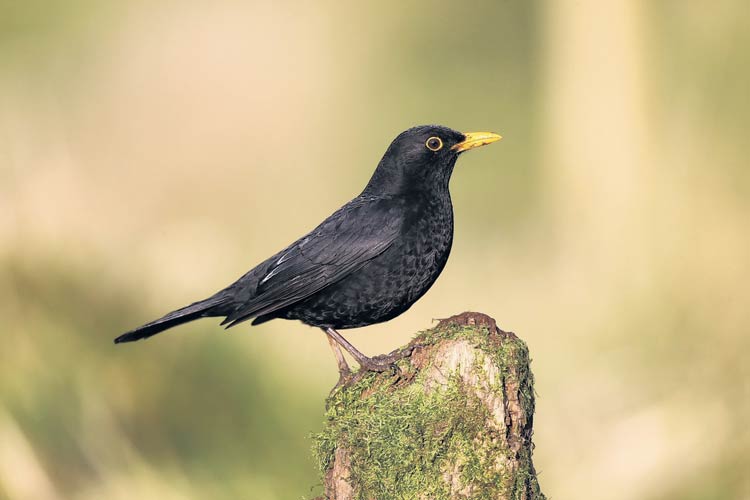
Detailed Data / Measurements
Blackbird (Turdus merula merula)
Length
- Males:
- Body length: 24–29 cm (9.4–11.4 in), average 26 cm (10.2 in)
- Wing length: 126–139 mm (4.96–5.47 in), average 133 mm (5.24 in)
- Tail length: 104–116 mm (4.09–4.57 in), average 110 mm (4.33 in)
- Bill length: 23–27 mm (0.91–1.06 in) from skull base
- Females:
- Body length: 23.5–28 cm (9.3–11.0 in), average 25.5 cm (10.0 in)
- Wing length: 122–134 mm (4.80–5.28 in), average 128 mm (5.04 in)
- Tail length: 102–114 mm (4.02–4.49 in), (108 mm (4.25 in))
- Bill length: 22–26 mm (0.87–1.02 in) from skull base
Notes: Males are slightly larger than females, which is typical for sexual dimorphism in thrushes. Body length can vary depending on the subspecies (e.g., T. m. azorensis is smaller) and geographical region.
Mass
The Blackbird’s body mass shows significant seasonal fluctuations, related to fat storage before winter and a decrease in mass after the breeding season. The data concern European populations (T. m. merula).
- Males:
- Range: 71–150 g (2.50–5.29 oz)
- Average: 102.8 g (3.63 oz)
- Highest mass: January (120–150 g (4.23–5.29 oz), with fat reserves
- Lowest mass: July–August (71–90 g (2.50–3.17 oz), after the breeding season
- Females:
- Range: 70–145 g (2.47–5.11 oz)
- Average: 100.3 g (3.54 oz)
- Highest mass: April–May (110–145 g (3.88–5.11 oz), during the egg-laying period
- Lowest mass: July–August (70–85 g (2.47–3.00 oz), after the breeding season
Notes: Females are on average 2–3 g lighter than males, except during the breeding season, when their mass may be higher due to developing eggs. One-year-old birds are approx. 3 g lighter compared to adults.
Seasonal mass fluctuations: The Blackbird’s body mass is strongly dependent on the season, which distinguishes it from species with more stable mass. In winter, birds store fat, increasing their mass by up to 30–40%.
Lifespan
- Average lifespan: 3.6 years (based on studies in cities in northwestern Germany). Maximum documented lifespan: 22 years and 3 months (a female ringed on Heligoland in 1974, recaptured in 1996).
- The maximum age (22 years) is exceptional and concerns a ringed individual, indicating potential longevity under favorable conditions.
- Mortality: In the first year of life, mortality is approx. 69% (survival rate 31%, data from France). In subsequent years, the annual survival rate is approx. 55%.
Notes: Lifespan is higher in cities, where food availability is greater and the threat from predators is lower (although the risk of collisions with vehicles increases). Older individuals are rare, but single birds can reach an age of over 10 years.
Speed
Data regarding the Blackbird’s flight speed is limited, as it is not a bird known for fast or long-distance flight, unlike, for example, migratory birds from the order Charadriiformes. Blackbirds move mainly in short flights between thickets and open spaces, and during migration, they cover distances in stages, mainly at night.
- Horizontal flight speed: Estimated 30–50 km/h (18.6–31.1 mph), based on observations of flight in passerines of similar build (Cramp, 1988).
- Migration speed: Average 20–40 km/h (12.4–24.9 mph), depending on weather conditions and wind. Blackbirds cross obstacles such as the North Sea or the Alps in short segments with frequent breaks.
- Ground movement speed: While foraging, blackbirds move by hopping or short bursts of running, with an estimated speed of 1–3 km/h (0.6–1.9 mph). After landing, they often take a few steps to brake.
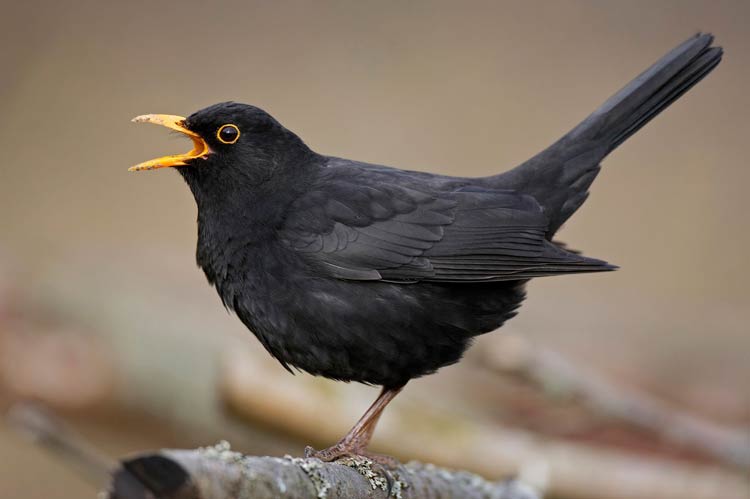
Common blackbird (Turdus merula) – Interesting Facts
The Blackbird (Turdus merula), one of Europe’s most recognizable birds, holds many fascinating facts that reveal its remarkable biology, behavior, and cultural significance. Below, we present the most interesting information about this singer.
- Master of Musical Improvisation The Blackbird is one of the most talented avian singers. Its melodic courtship songs, composed of catchy phrases, can contain over 30 different motifs that males compose by combining their own ideas with imitations of other birds and even ambient sounds. In cities, blackbirds incorporate sounds such as ambulance sirens, phone rings, or car horns into their repertoire. The German composer Heinz Tiessen called the blackbird “the most musically advanced songbird of Central Europe” due to its ability to create diatonic and chromatic melodies.
- Singing at Night in Cities Thanks to artificial lighting in cities, blackbirds often sing at night, especially in areas illuminated by streetlamps. This unusual behavior makes them one of the few birds that can be heard after dark, lending urban parks an almost magical atmosphere. Night singing is particularly intense in spring, when males compete for territory and mates.
- Synurbanization – An Urban Bird Blackbirds were originally forest birds, but in the 19th century, they began the process of synurbanization, colonizing parks and gardens first, and then city centers. In Bamberg and Erlangen (Bavaria), urban blackbirds were recorded as early as 1820, and in Rome in 1828. Today, in cities like London and Warsaw, they reach record densities – up to 4–7 breeding pairs per hectare (approx. 1.6–2.8 pairs/acre), compared to 0.5 pairs (approx. 0.2 pairs/acre) in forests. Adaptation to urban life includes a reduced tendency for migration and lower stress levels (less corticosterone secretion).
- Unusual Nests In cities, blackbirds build nests in surprising places: in wall-mounted flowerpots, on joists, in the engine compartments of parked cars, and even on neon letters (with a preference for round letters and avoiding red color). Nest construction, carried out by the female, takes 2–5 days and utilizes natural materials (twigs, moss, mud) but also trash, such as pieces of plastic or paper.
- Leucism and Albinism Although male blackbirds are known for their black plumage, rare cases of leucism (partial pigment loss) or albinism (complete pigment loss) occur, particularly in urban populations. White or pied blackbirds were described as early as by Aristotle. Experiments have shown that leucism may be related to protein deficiency in the diet during molting, leading to the formation of white feathers.
- Unihemispheric Sleep The Blackbird is one of the few bird species in which unihemispheric slow-wave sleep has been documented. During sleep, one half of the brain remains active (in a vigilant state), while the other “sleeps,” allowing the bird to rest while maintaining partial alertness. Such episodes last 2–4 seconds and occur for 140–200 seconds throughout the night when the bird holds its beak pointed forward.
- Sunbathing and Anting Blackbirds regularly sunbathe, lying flat on the ground with spread wings and tail to expose their feathers to the sun. Even more unusual is anting – birds lie on ant nests (e.g., Yellow Meadow Ants (Lasius flavus)), allowing the insects to crawl among their feathers. This is thought to have an anti-parasitic effect, although the exact purpose remains unclear.
- Symbolism and Superstitions In Christian culture, the blackbird, due to its black plumage and solitary lifestyle in forests, was a symbol of pious hermits. The legend of St. Kevin tells that a blackbird built a nest in his hands folded in prayer, and the saint remained still so as not to disturb the brood. In folklore, it was believed that the blackbird protects the house from lightning, and a feather from its right wing, hung on a thread, causes insomnia. In northern Italy, the last days of January are called “the days of the blackbird” (I giorni della merla), from the legend of white blackbirds that turned black from soot while hiding in a chimney.
- Introduction in Australia and New Zealand Blackbirds were introduced to Australia in 1857 (Melbourne) and to New Zealand in the 1860s. In Australia, they are considered pests, damaging orchards and vineyards, leading to their culling. In New Zealand, they have spread to surrounding islands and can facilitate the spread of invasive plant species by dispersing seeds. Interestingly, the songs of New Zealand blackbirds do not differ from European ones.
- Usutu Virus – “Blackbird Dying” From 2001–2011, the Usutu virus, transmitted by mosquitoes, caused mass die-offs of blackbirds in Central Europe, particularly in Austria, Germany, and Hungary. In 2011 in Germany, approx. 100,000 individuals died. Austrian populations developed population immunity by 2006, allowing for a return to their normal state.
- Unusual Feeding Habits Although blackbirds prefer earthworms, beetles, and berries, cases of coprophagy (eating feces), cannibalism, and predation on the nests of other birds, such as sparrows or other thrushes, have been recorded. In extreme situations, blackbirds catch fish or prey on small vertebrates, such as lizards or mice.
- Inspiration in Music and Literature The Blackbird’s song has inspired many artists. The band The Beatles used its melody in the song Blackbird (1968), symbolizing the struggle for African-American rights. The French composer Olivier Messiaen created the piece Le Merle noir for flute and piano, paying tribute to the blackbird. In literature, the bird appears in works by poets such as Jan Brzechwa (the poem ‘Kos’) and Robert Musil (Die Amsel), as a symbol of beauty and freedom.
